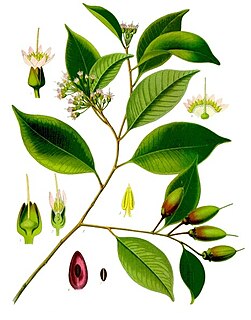
Scaevola is a genus of flowering plants in the Goodenia family, Goodeniaceae. It consists of more than 130 species, with the center of diversity being Australia and Polynesia. There are around 80 species in Australia, occurring throughout the continent, in a variety of habitats. Diversity is highest in the South West, where around 40 species are endemic.
Madhuca microphylla is a species of flowering plant in the family Sapotaceae. It is endemic to Sri Lanka, where it has been found in only two locations.

Payena is a genus of plants in the family Sapotaceae described as a genus in 1844.

Saurauia is a genus of plants in the family Actinidiaceae. It comprises about over 300 species distributed in the tropics and subtropics of Asia and South and Central America. Genetic evidence and the cell biology of the group support monophyly of the genus. Monophyly of the genus is also supported by micromorphological characters and by phylogenetic analysis, although the exact evolutionary relationships of Saurauia with the other two genera of the Actinidiaceae, Actinidia and Clematoclethra, are not well understood. It is also the only extant genus within its family whose natural distribution includes areas outside of Asia.
Saurauia bracteosa is a species of plant in the Actinidiaceae family. It is found in Java and Bali in Indonesia.
Saurauia cauliflora is a species of plant in the Actinidiaceae family. It is endemic to Java, Indonesia.
Saurauia lanceolata is a species of plant in the Actinidiaceae family. It is endemic to Java in Indonesia.
Saurauia latipetala is a species of plant in the Actinidiaceae family. It is found in Guatemala and Mexico. It is threatened by habitat loss.
Saurauia leucocarpa is a species of plant in the Actinidiaceae family. It is endemic to Mexico.
Saurauia mahmudii is a species of plant in the family Actinidiaceae. It is a tree endemic to Peninsular Malaysia. It is threatened by habitat loss.
Saurauia malayana is a species of plant in the family Actinidiaceae. It is a tree endemic to Peninsular Malaysia. It is threatened by habitat loss.
Saurauia oreophila is a species of plant in the Actinidiaceae family. It is found in Guatemala and Mexico. It is threatened by habitat loss.
Saurauia pustulata is a species of plant in the Actinidiaceae family. It is endemic to Mexico.
Saurauia rubens is a species of plant in the family Actinidiaceae. It is a tree endemic to Peninsular Malaysia. It is threatened by habitat loss.
Saurauia scabrida is a species of plant in the Actinidiaceae family. It is endemic to Mexico.
Saurauia serrata is a species of plant in the Actinidiaceae family. It is endemic to Mexico.
Saurauia villosa is a species of plant in the Actinidiaceae family. It is endemic to the Mesoamerican countries of Mexico, Guatemala, El Salvador, and Honduras. It is a small tree found in cloud forests, as well as pine-oak forests and secondary forests.

Angiopteris evecta, commonly known as the king fern, giant fern, elephant fern, oriental vessel fern, Madagascar tree fern, or mule's Foot fern, is a very large rainforest fern in the family Marattiaceae native to most parts of Southeast Asia and Oceania. It has a history dating back about 300 million years, and is believed to have the longest fronds of any fern in the world.
Payena microphylla is a tree in the family Sapotaceae. It grows up to 45 metres (150 ft) tall with a trunk diameter of up to 160 centimetres (60 in). The bark is black to reddish brown. Inflorescences bear up to 15 flowers. The fruits are ovoid to ellipsoid, up to 4 cm (2 in) long. The specific epithet microphylla is from the Greek meaning "small-leaved". Habitat is lowland mixed dipterocarp to montane forest, from sea level to 2,000 metres (6,600 ft) altitude. P. microphylla is endemic to Borneo.




